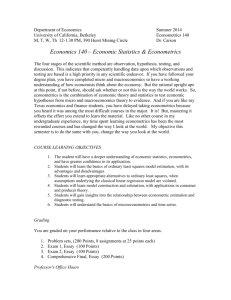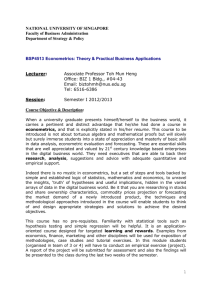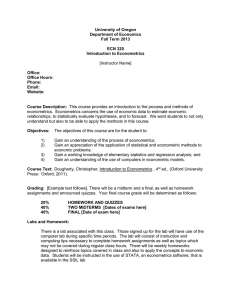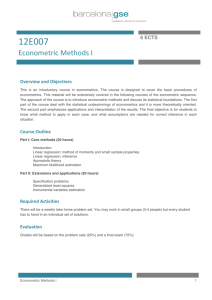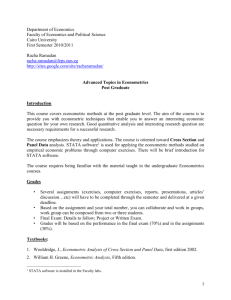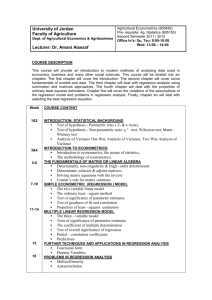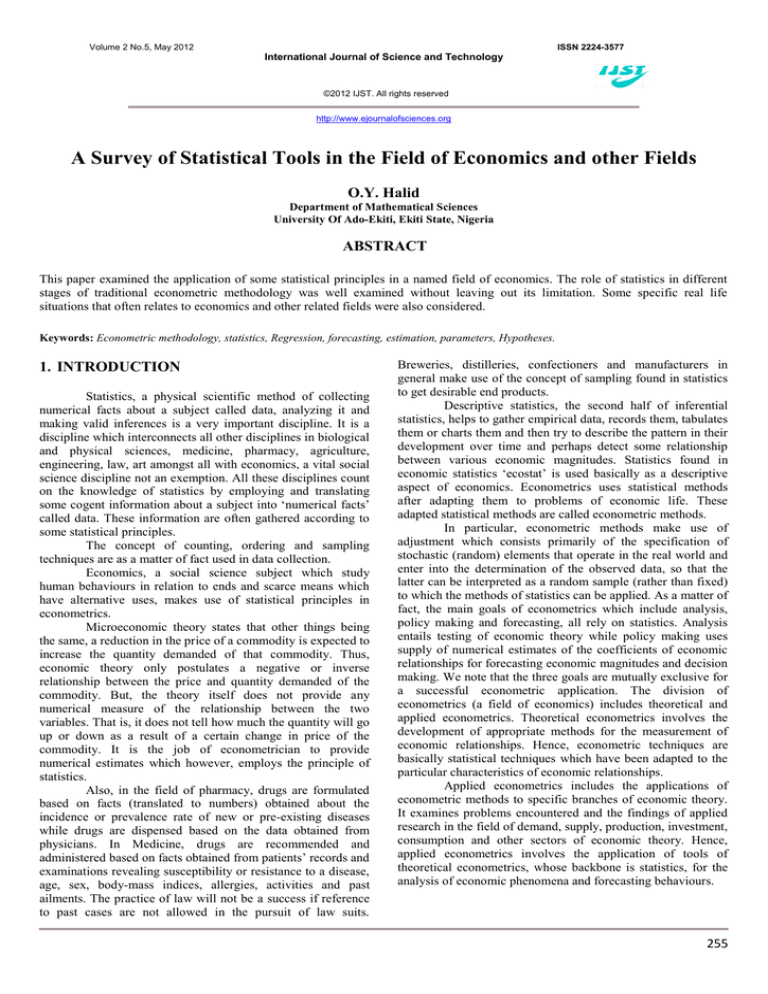
Volume 2 No.5, May 2012
ISSN 2224-3577
International Journal of Science and Technology
©2012 IJST. All rights reserved
http://www.ejournalofsciences.org
A Survey of Statistical Tools in the Field of Economics and other Fields
O.Y. Halid
Department of Mathematical Sciences
University Of Ado-Ekiti, Ekiti State, Nigeria
ABSTRACT
This paper examined the application of some statistical principles in a named field of economics. The role of statistics in different
stages of traditional econometric methodology was well examined without leaving out its limitation. Some specific real life
situations that often relates to economics and other related fields were also considered.
Keywords: Econometric methodology, statistics, Regression, forecasting, estimation, parameters, Hypotheses.
1. INTRODUCTION
Statistics, a physical scientific method of collecting
numerical facts about a subject called data, analyzing it and
making valid inferences is a very important discipline. It is a
discipline which interconnects all other disciplines in biological
and physical sciences, medicine, pharmacy, agriculture,
engineering, law, art amongst all with economics, a vital social
science discipline not an exemption. All these disciplines count
on the knowledge of statistics by employing and translating
some cogent information about a subject into ‘numerical facts’
called data. These information are often gathered according to
some statistical principles.
The concept of counting, ordering and sampling
techniques are as a matter of fact used in data collection.
Economics, a social science subject which study
human behaviours in relation to ends and scarce means which
have alternative uses, makes use of statistical principles in
econometrics.
Microeconomic theory states that other things being
the same, a reduction in the price of a commodity is expected to
increase the quantity demanded of that commodity. Thus,
economic theory only postulates a negative or inverse
relationship between the price and quantity demanded of the
commodity. But, the theory itself does not provide any
numerical measure of the relationship between the two
variables. That is, it does not tell how much the quantity will go
up or down as a result of a certain change in price of the
commodity. It is the job of econometrician to provide
numerical estimates which however, employs the principle of
statistics.
Also, in the field of pharmacy, drugs are formulated
based on facts (translated to numbers) obtained about the
incidence or prevalence rate of new or pre-existing diseases
while drugs are dispensed based on the data obtained from
physicians. In Medicine, drugs are recommended and
administered based on facts obtained from patients’ records and
examinations revealing susceptibility or resistance to a disease,
age, sex, body-mass indices, allergies, activities and past
ailments. The practice of law will not be a success if reference
to past cases are not allowed in the pursuit of law suits.
Breweries, distilleries, confectioners and manufacturers in
general make use of the concept of sampling found in statistics
to get desirable end products.
Descriptive statistics, the second half of inferential
statistics, helps to gather empirical data, records them, tabulates
them or charts them and then try to describe the pattern in their
development over time and perhaps detect some relationship
between various economic magnitudes. Statistics found in
economic statistics ‘ecostat’ is used basically as a descriptive
aspect of economics. Econometrics uses statistical methods
after adapting them to problems of economic life. These
adapted statistical methods are called econometric methods.
In particular, econometric methods make use of
adjustment which consists primarily of the specification of
stochastic (random) elements that operate in the real world and
enter into the determination of the observed data, so that the
latter can be interpreted as a random sample (rather than fixed)
to which the methods of statistics can be applied. As a matter of
fact, the main goals of econometrics which include analysis,
policy making and forecasting, all rely on statistics. Analysis
entails testing of economic theory while policy making uses
supply of numerical estimates of the coefficients of economic
relationships for forecasting economic magnitudes and decision
making. We note that the three goals are mutually exclusive for
a successful econometric application. The division of
econometrics (a field of economics) includes theoretical and
applied econometrics. Theoretical econometrics involves the
development of appropriate methods for the measurement of
economic relationships. Hence, econometric techniques are
basically statistical techniques which have been adapted to the
particular characteristics of economic relationships.
Applied econometrics includes the applications of
econometric methods to specific branches of economic theory.
It examines problems encountered and the findings of applied
research in the field of demand, supply, production, investment,
consumption and other sectors of economic theory. Hence,
applied econometrics involves the application of tools of
theoretical econometrics, whose backbone is statistics, for the
analysis of economic phenomena and forecasting behaviours.
255
Volume 2 No.5, May 2012
ISSN 2224-3577
International Journal of Science and Technology
©2012 IJST. All rights reserved
http://www.ejournalofsciences.org
2. ROLES
AND
STATISTICS
IN
ECONOMICS
LIMITATION
THE
FIELD
OF
OF
commodities, I consumers’ income and T the tastes while
0 , 1 , 2 , 3 and 4 are the coefficients of the demand
equation.
Econometrics, a field of economics employs statistical methods
after adapting them to problems of economic life. This section
highlights the procedures to be followed when testing an
economic theory, the relevance of statistics to these procedures
as well as the limitation of statistics in this area. These
procedures are presented schematically as follows:
The o ry
Mod el o f
the o ry
The demand equation (1) above is exact because it implies that
the only determinants of the quantity demanded are the four
factors which appear on the right hand side of the equation. The
quantity demanded will change only if some of these factors
change. No other factor may have effect on demand. Yet, It is
common knowledge that in economic life that many more
factors may affect demand. The invention of a new product, a
war, professional changes, changes in law, changes in income
distribution, immigration or emigration may influence demand.
Human erratic behaviour influenced by rumours, prejudice,
traditions and many more may also make demand fluctuate.
These ‘unforeseen factors’ are taken into account by the
introduction of a random variable (defined as the result of a
statistical experiment) with specific characteristics so that the
demand function (1) is written in stochastic form as
Da ta
Q = 0 1P + 2 P0 +3 I + 4T i
Hyp othesis
Ac ce pt
the o ry
Re ject theo ry
Re vise theo ry
Fo re ca sting
Confronta tion
with New Data
App lic a tio n of
m od el for
p olic y purpo se
Figure 1: An Economic Theory is always Formulated by using
Statistical Ideas
An illustration stated below will make this clearer.
Economic theory postulates that the demand for a commodity
depends on its price, on the prices of other related commodities,
on consumers’ income and tastes. This is an exact relationship
because it implies that demand is completely determined by the
above four factors. No other factor, except those explicitly
mentioned influences the demand.
Thus, the demand equation is written as
Q = 0 1P + 2 P0 +3 I + 4T
(1)
Where Q is the quantity demanded of a particular commodity,
P the price of the commodity, P0 the price of other related
(2)
Where i represents random factors which affect the
quantity demanded.
This step in the theory modeling is a key step towards
accuracy achieved by statistical principle. The next step is to fit
the model to observational data referring to actual behaviour of
economic units-consumers or producers. The aim of this stage
is to establish whether the theory can explain the actual
behaviour of the economic units. If it does, we accept the
theory as valid. If not, we reject the theory or we may modify
the theory using additional new observations. This is achieved
by estimation of model for its parameters.
The size of parameter estimates are of great
significance in any case (McCloskey and Ziliak). The reliability
of estimates is of greater significance in inference (Engsted)
Estimation of model is a purely technical stage which
requires the knowledge of various econometric methods, their
assumptions and the economic implication of the estimates of
the parameters. Apart from estimation, the reliability and
validity of the results is carried out by statistical theory found
in parameter significance tests. In the nut shell, traditional
methods of getting reliable estimates as well as accurate model
fits come in tune with the method of least squares and
coefficient of determination since we seek the best model for
our data from a list of models by considering the model with
the least error sum of squares (ESS) and the highest coefficient
of determination value.
Researchers have argued that significance tests are
useful tools in those cases where statistical models often serve
as input in the quantification of an economic model (Engsted),
hence it is important that the statistical models are well
specified. In certain areas of macro economics, researchers
clearly distinguish between statistical testing and economic
significance. It is stated that where statistical testing plays a
relatively minor role in model evaluation, models are inherently
256
Volume 2 No.5, May 2012
ISSN 2224-3577
International Journal of Science and Technology
©2012 IJST. All rights reserved
http://www.ejournalofsciences.org
mispecified and consequently are evaluated empirically by
other methods than statistical tests.
The limitation of statistics lies in the fact that its
methods of measurements are sometimes developed on the
basis of controlled experiments in laboratories. Hence,
statistical methods of measurement are not considered
appropriate for economic relationships, which cannot be
measured on the basis of controlled experiments because such
experiments cannot be designed for economic phenomena.
M t = 1 R t 2 Yt3 et
where
(6)
M t depicts the derived or long-run demand for money,
Rt the long term interest rate and Yt the aggregate real
national income.
The estimation may also be carried out conveniently by
linearizing (6)
3. APPLICATION OF STATISTICAL TOOLS
IN
ECONOMETRICS
AND
OTHER
RELATED SITUATIONS
So that (6) becomes;
We are familiar with the idea of a model in everyday
life, and we can readily visualize a range of models of varying
complexity and sophistication. Models are used in various
walks of professional life since they are small scale
representations of specific physical entities.
The concepts of demand and supply are ideally
modeled by regression in economics. The beauty of regression
lies in the establishment of relationships between variables
while the major task of modeling lies in its accuracy.
‘Modeling via regression’ gave several important results some
of which are considered below:
The Logistic Model
ln M t = ln1 2lnR t 3 ln Yt t
(7)
This model is popular with population growth. It is of the form
Yt =
1
1 + e
2 3t
+ t
(8)
Yt represents the population, t the time measured
The Cobb-Douglas Model
chronologically while
This is a non-linear function of the form
Yt = 1 X 2t2 X 3t3 e t , t = 1, 2 ,…
(3)
1, 2 and 3
are the parameters of
the model.
As a result, a data of U.S. population growth between 19701999 was fitted to it so that an estimated U.S. population
growth model
1432.739
1 + e1.7966 - 0.0117t
Yt representing the output (GDP), X 2t the labour intput
and X 3t the capital input.
Yt =
Linearizing (3) by taking the natural logarithm, it yields:
was obtained.
ln Yt = + 2 ln X 2t 3 ln X 3t t
(9) measures the underlying growth rate of the U.S. population
w.r.t. time
with
where
ln 1
(4)
This model was proposed for the analysis of the
Mexican Economy by estimating its parameters.
A production function data of Mexican economy
between 1955-1974 was fitted to the model and the estimated
Cobb-Douglas function was found to be
GDP 0.5292Labourt0.1810Capitalt0.8827 (5)
The labour and capital inputs may be adjusted to
give desirable GDP (output). The Cobb-Douglas model was
also proposed for the demand for money in Canada by respecifying the variables as follows, so that
(9)
The Polynomial Regression Model
The polynomial regression model of the third degree with form
Yi = 0 + 1 X i + 2 X i2 3 X i3 , i = 1, 2, …. , n (10)
was proposed for a data of total production cost ( Yi ) and output
( X i ) of a commodity given below, since its scatter diagram
resembles an elongated S-shape whose pattern follows the
much celebrated law of diminishing returns.
257
Volume 2 No.5, May 2012
ISSN 2224-3577
International Journal of Science and Technology
©2012 IJST. All rights reserved
http://www.ejournalofsciences.org
4. CONCLUSION
Outpu
t
TPC
1
2
3
4
5
6
7
8
9
10
19
3
22
6
24
0
24
4
25
7
26
0
27
4
29
7
35
0
42
0
total production cost vs output
450
400
350
Some roles of regression, a field of statistics have been
examined in a field of economics and other real life situations.
The limitations of statistical application to the field of
economics had been also discussed. Some important
application of regression as a statistical tool for estimation was
also discussed with their applications to some popular
econometric models.
In econometrics, data collection techniques, model
specification, model estimation, forecasting and hypothesis
testing make use of statistical principles, I therefore conclude
that econometric methods are statistical methods specifically
designed for peculiarities of economic phenomena and other
real life situations.
Again, since other disciplines adopt and rely on the
use of past information facts (data) in their practices, I also
conclude that statistics is indispensable in all other disciplines.
300
REFERENCES
250
TPC
[1] Damodar .N. Gujarati (2003) Basic Econometrics
McGraw-Hill Co.
200
150
[2] Economic Reports of the U.S. president 2000
100
[3] Neter J., Kutner M.H., Nachtsheim C.J. and
Wasserman W. (1996) Applied Regression Analysis
Third Edition, Irwin Pub.Co.
50
0
0
5
10
15
Fig.2
We fitted the data to the proposed model in (10) above so that
we have an estimated model
Yi = 141.7667 + 63.4776Xi 12.9615X + 0.9396X
2
i
3
i
(11)
There are countless number of useful models in different areas of
statistics.
[4] Koutsoyiannis A. (2003) Theory of Econometrics
Palgrave Publishing Ltd.
[5] McCloskey D. and Ziliak S. (2008) Statistical vs.
Economic
Significance
in
Economics
and
Econometrics Journal of Economic Methodology
March 2008
[6] Wojtek J. Krzanowski (1998) An Introduction to
Statistical Modeling Arnold Publishers & Oxford
University Press Inc.http://www.arnoldpublishers.com
[7] T. Engsted (2009) Statistical vs. Economic
Significance inEconomics and Econometrics: Further
comments Journal of Economic Methodology march
2009
258



